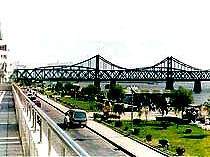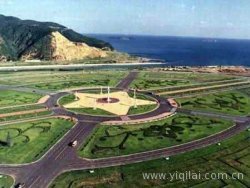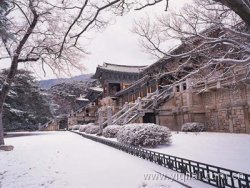Study in Liaoning

Liaoning Province, often called ’the Golden Triangle’ because of its superior geographical location, includes boundaries on the Yellow Sea, the Bohai Gulf, and the Yalu River, which makes Liaoning the closest gateway to the Korean Peninsula. As the southernmost province of the three provinces in northeast China, Liaoning Province’s proximity to the sea has given it commercial and strategic advantages throughout its history.
History
Archeological evidence establishes that community life existed in Liaoning 5,000 years ago. From its early beginnings through to the mid-20th Century, Liaoning has been sought after as an important trade center, an area that contains rich, untapped resources, and for its strategic position as the Golden Triangle. Liaoning has been the birthplace of warlords and the cradle of the Qing Dynasty. Lasting from 1644 to the 1911 Revolution, this feudal dynasty was set up by invading Manchus. Unfortunately, the Manchus were not the last people to invade this area. Liaoning’s often troubled history has given us an interesting legacy of architecture and artifacts, as well as archeological treasures, which combined with its transcendent natural beauty, makes Liaoning Province an area you will want to visit many times. Below are a few highlights.
What to see
In Shenyang, Liaoning’s capital city, there is a Manchu version of the Forbidden City known as the Shenyang Imperial Palace. Built on the same principles as the Forbidden City in Beijing, although much smaller in scope, it was completed by Huang Taiji in 1636. Second only to the Forbidden City, it is the most intact imperial building in existence in China. The Imperial Palace is a museum that features extensive exhibits of jade, ivory, artworks of Ming and Qing dynasties (including paintings, sculpture, enamels and ceramics), musical instruments, and a large display of 17th and 18th Centuries military equipment. It was in this palace in 1644 that Shunzhi became Emperor before he crossed the Great Wall to invade China.

The emperors that built the Imperial Palace also built their burial sites in Shenyang: Fuling Tomb also called the East Tomb; and Zhaoling Tomb, also called the North Tomb. Emperor Nurhachi and his mistress are buried in Fuling Tomb. Nurhachi’s son, Huang Taiji (the father of Emperor Shunzhi) and his empress are buried in Zhaoling. The large and beautiful Zhaoling tomb has been compared to the Ming Tombs in Beijing and is located in the enormous Beiling Park. A third tomb, Yongling Tomb, completes the famous tomb group known as the ’three tombs outside of the Great Wall’.
In some very ancient time, a fairy goddess decided to bring spring to Earth by embroidering clouds on lotus leaves. During a fight with the gods who were trying to stop her, the beautiful cloud embroidered leaves fell to earth at Shenyang and became green hills that the people named Qianlianshan (Thousand Lotuses Mountain). This mountain is now known as Qianshan. People love to come here to walk along the splendid trails to its lofty peaks and ancient temples. A walk around Qianshan can give you the memory of a perfect day.
Southeast of Shenyang is Benxi, which has the largest water cave in Asia. Within 45 square kilometers (17 square miles) of Benxi Water Cave National Park, there are six areas of particular interest: Mount Miaohou, Mount Tiecha, Mount Guanmen, the Spa Temple, Tanggou Valley, and the Water Cave. The Water Cave has an underground river with water so clear that the riverbed is always visible. Take a ride on the sightseeing boat and enter into the magic and mystery of the stalactite formations that have formed over millions of years. It is common to see artists at the various mountains and Tanggou Valley drawing and painting the mountains and the innumerable flowers and trees that are nurtured by the mountain streams. Benxi Water Cave National Park is a unique wonderland of pastoral beauty that has captured the imagines and hearts of its visitors throughout the ages.
Surrounded on three sides by the Yellow Sea, Dalian is a charming coastal city that has become a popular resort town. This is hardly surprising when you experience the garden-like downtown streets that are bordered by Japanese and Russian style buildings, all of which provide the perfect backdrop for a leisurely stroll. With mountains on one side, and fabulous bathing beaches all around the city, Dalian is a great place to escape the summer heat, have a refreshing vacation, and enjoy the feeling of romance that is in the air.
Liaoning Province is opulent in natural beauty as well as interesting attractions. Aside from the ones noted above, there are also: Fenghuang Mountain; Shenya Aquarium in Xinghai Bay Resort has more than 7,000 fish; Dalian’s Nest Cliff and Tiger Beach, which has the largest aviary in China (18,000 square meters or 6,950 square miles) and possibly the largest animal sculpture in the world; the 300,000-year-old Yingkou Jinniushan Relic, Phoenix Mountain, and Bingyu Valley. We must mention Tiecha Mountain, which is located east of Benxi. Because its eastern, southern and northern peaks can be seen from three sides, it is also known as Jiu Ding (Nine Tops). Among this mountain’s many caves is Yunguang Cave, which houses eight treasures: stone dragon, stone toad, stone fish, stone bed, stone lotus, stone longevity and ’the wind that calms the pearl’. This mountain, which is considered the birthplace of Taoism in Northeast China, has a great amount of interesting, ancient calligraphy carved into its rocks.
Liaoning Province has frequent and quite special festivals that are not to be missed. Among them are: Dalian Spring Fireworks Festival, Dalian Chinese Scholar Tree Blossom Affairs, Dalian International Fashion Festival, and Shenyang International Ice and Snow Festival. Consider planning your trip to include one of Liaoning’s wonderful festive events.
Population: Approx. 40 million
Area: 150 thousand square kilometers (about 57,918 square miles)
Ethnic Minority: Manchu, Hui, Mongolian, Xibe and Korean
When to go

Continental climate characterized by long and cold winters, warm and rainy summers and comparatively short and windy spring and autumn. January is the coldest month with an average temperature of -17 Cto -5 Cto -5 C, and July is the hottest with an average temperature of 21 C, and July is the hottest with an average temperature of 21 C-25 C-25 C. Annual rainfall of this province averages from 450 millimeters to 1150 millimeters. Liaoning is the province in northeast China having the most sunlight, heat, and rainfall. The best time to visit is from May to October, but winter is also a pleasant time to enjoy the ice and snow scenery and winter festivals. C. Annual rainfall of this province averages from 450 millimeters to 1150 millimeters. Liaoning is the province in northeast China having the most sunlight, heat, and rainfall. The best time to visit is from May to October, but winter is also a pleasant time to enjoy the ice and snow scenery and winter festivals.
Universities in Liaoning
|




